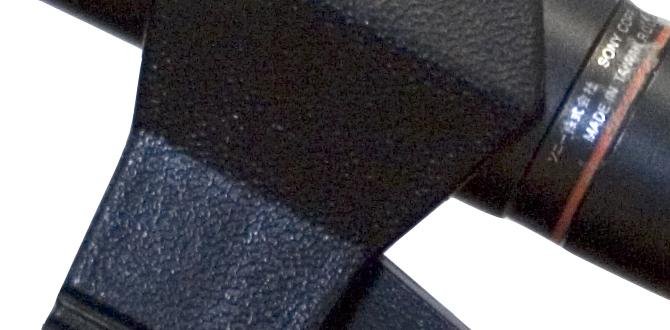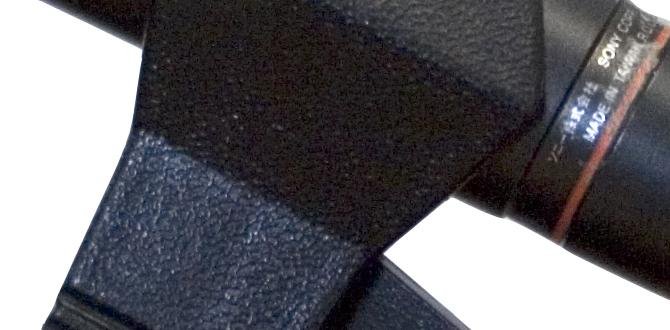Quick Summary:
Choosing the right TV panel type—whether LED, QLED, OLED, or Mini-LED—significantly impacts picture quality and viewing experience. This guide reviews each type, explaining their core technology and benefits in simple terms to help you find the perfect TV for your home.
Hey everyone, Bob E Riley here from Aimguider! Ever stood in front of a wall of TVs at the store, feeling a little overwhelmed by all the tech talk? You’re not alone! The “panel type” is one of those things that sounds complicated but is actually super important for how good your favorite shows and movies will look. Don’t sweat it; I’m here to break it all down for you. We’ll look at what makes each panel tick, what that means for your living room, and how to pick the best one without needing a degree in engineering. Ready to see the picture more clearly?
Understanding TV Panel Types: Your Essential Guide
When you’re shopping for a new TV, you’ll hear a lot of buzzwords like LED, QLED, OLED, and Mini-LED. These aren’t just fancy marketing terms; they refer to the core technology that lights up your screen and creates the image. Each type has its own strengths and weaknesses, impacting everything from color vibrancy and contrast to viewing angles and price. Understanding these differences is the first step to making a smart purchase that you’ll love for years to come. Let’s dive in and demystify these panel types!
What is a TV Panel Anyway?
Think of the TV panel as the main stage where the magic happens. It’s the part of your TV that displays the actual picture. Behind this screen, there’s a light source that illuminates it, and the type of panel technology dictates how that light is controlled and how colors are produced. This control over light is what ultimately determines how vivid, bright, and contrasty your picture looks.
Different panel types use different methods to create light and color. Some use tiny light-emitting diodes (LEDs) to backlight the screen, while others use organic light-emitting diodes (OLEDs) where each pixel lights up independently. The technology behind these panels has evolved rapidly, leading to incredible improvements in picture quality that can truly transform your home entertainment experience.
Choosing the right panel type means understanding how these technologies work and what benefits they offer. It’s about matching the technology to your viewing habits, your room’s lighting, and your budget. We’re going to explore the most common types you’ll encounter, so you can feel confident when you see those specs.
The Main Players: LED, QLED, OLED, and Mini-LED Explained
Let’s get down to the nitty-gritty. You’ll primarily see four main types of TV panels on the market today. Each has its own unique way of producing an image, which leads to distinct advantages and disadvantages. We’ll break them down one by one, keeping it simple.
LED (Light Emitting Diode) TVs
LED TVs are the most common type you’ll find on the market, and they’re essentially a more advanced version of older LCD TVs. The “LED” part refers to the type of backlight used. In an LED TV, LEDs are used to illuminate the liquid crystal display (LCD) screen. The light passes through the LCDs, which then act like tiny shutters to block or allow light through, creating the image you see.
How they work: A layer of LEDs behind or around the edge of the LCD panel provides the light. This backlight shines through the LCD pixels. The quality of the backlight and how it’s managed can vary greatly, impacting the TV’s contrast and black levels.
Types of LED Backlighting:
- Edge-Lit LED: LEDs are placed along the edges of the screen, with light guides that spread the illumination across the panel. These TVs tend to be thinner and cheaper but can sometimes suffer from uneven brightness.
- Full-Array LED: LEDs are arranged in a grid across the entire back of the panel. This allows for better control over brightness in different zones, leading to improved contrast and black levels compared to edge-lit models.
- Full-Array with Local Dimming (FALD): This is an advanced form of Full-Array LED. The TV can individually dim or brighten specific zones of LEDs behind the screen. This dramatically improves contrast, letting the TV achieve deeper blacks in dark scenes and brighter whites in bright scenes without affecting each other.
Pros of LED TVs:
- Wide range of prices, often a budget-friendly option.
- Generally very bright, making them good for well-lit rooms.
- Durable and widely available.
Cons of LED TVs:
- Black levels and contrast can be less impressive than other types, especially on edge-lit models.
- Potential for “blooming” or halo effects around bright objects on dark backgrounds, particularly with local dimming.
- Viewing angles can be narrower than OLED.
QLED (Quantum Dot Light Emitting Diode) TVs
QLED technology is a step up from standard LED TVs. Developed by Samsung and promoted by other brands, QLED TVs use an extra layer of tiny particles called “quantum dots” placed between the LED backlight and the LCD screen. These quantum dots are incredibly efficient at producing pure, vivid colors when hit by light from the LEDs. This results in a wider color spectrum and brighter images compared to traditional LED TVs.
How they work: QLED TVs still use an LED backlight and an LCD layer. However, the quantum dot layer acts as a color enhancer. When the LED backlight shines through this layer, the quantum dots convert blue light into incredibly pure red and green light. This allows the TV to display a wider range of colors that are more accurate and vibrant.
Pros of QLED TVs:
- Excellent color reproduction and brightness, often surpassing standard LED TVs.
- Good for bright rooms due to their high peak brightness.
- Wide range of sizes and price points available.
- Durable technology.
Cons of QLED TVs:
- Still rely on a backlight, so they can’t achieve perfect black levels like OLEDs.
- Black uniformity and contrast can be an issue, though FALD helps significantly.
- Viewing angles are generally good but can degrade color and contrast noticeably at extreme angles.
OLED (Organic Light Emitting Diode) TVs
OLED technology is quite different and often considered the gold standard for picture quality. In an OLED TV, each individual pixel produces its own light. This means that when a pixel needs to be black, it simply turns off completely. This self-emissive nature allows for incredible contrast ratios, perfect blacks, and vibrant colors without any light bleed.
How they work: Each pixel in an OLED panel is made of organic compounds that emit light when electricity is applied. There’s no need for a separate backlight. This direct pixel control is what gives OLED its signature perfect blacks and infinite contrast.
Pros of OLED TVs:
- Perfect black levels and infinite contrast, leading to stunning depth and realism.
- Extremely wide viewing angles with minimal color or brightness degradation.
- Incredibly fast response times, making them excellent for gaming and fast-action scenes.
- Very thin panel designs are possible.
Cons of OLED TVs:
- Generally more expensive than LED or QLED TVs.
- Peak brightness is typically lower than high-end QLED or Mini-LED TVs, which can be a consideration for very bright rooms.
- While rare with modern OLEDs, there’s a theoretical risk of “burn-in” (permanent image retention) if static images are displayed for extremely long periods at high brightness, though manufacturers have implemented many safeguards.
For more on how these technologies achieve their displays, you can check out resources like DisplayMate’s in-depth display technology explanations.
Mini-LED TVs
Mini-LED is an evolution of LED TV technology that aims to bridge the gap between traditional LEDs and OLED. Instead of just hundreds of LEDs in a backlight, Mini-LED TVs use thousands of much smaller LEDs. These tiny LEDs are grouped into many more dimming zones than a standard Full-Array LED TV, allowing for much finer control over brightness and contrast across the screen.
How they work: Mini-LED TVs still use an LCD panel for image display, but their backlight is made up of thousands of miniature LEDs. These LEDs are divided into hundreds or even thousands of individually controllable dimming zones. This high number of zones allows for much more precise control over the light, enabling deeper blacks and brighter highlights simultaneously, significantly improving contrast and reducing the blooming effect.
Pros of Mini-LED TVs:
- Excellent brightness levels, often exceeding QLED and approaching even the brightest LED displays.
- Greatly improved contrast and black levels compared to standard LED TVs, thanks to the increased number of dimming zones.
- More affordable than OLEDs while offering very competitive picture quality.
- Less susceptible to burn-in than OLEDs.
Cons of Mini-LED TVs:
- While much improved, they can still exhibit some blooming or haloing around bright objects on dark backgrounds, as dimming zones are not as granular as individual OLED pixels.
- Viewing angles can be better than standard LED but may not match OLED’s perfection.
- Can be more expensive than standard LED TVs.
Comparing TV Panel Types: A Quick Overview
To help you visualize the differences and strengths, let’s put it all together in a comparison table. This should give you a quick snapshot of what each panel type excels at. Remember, within each category (like LED), there are different quality tiers, but this table highlights the general characteristics.
| Feature | LED TV (Standard) | QLED TV | OLED TV | Mini-LED TV |
|---|---|---|---|---|
| Black Levels | Good to Fair | Good to Very Good | Perfect | Very Good to Excellent |
| Contrast Ratio | Good | Very Good | Infinite | Excellent |
| Brightness | Good | Very Good to Excellent | Good to Very Good | Excellent |
| Color Accuracy & Vibrancy | Good | Excellent | Excellent | Excellent |
| Viewing Angles | Fair to Good | Good to Very Good | Excellent | Good to Very Good |
| Response Time | Good | Good | Excellent | Good to Very Good |
| Price Range | Budget-Friendly to Mid-Range | Mid-Range to High-End | High-End | Mid-Range to High-End |
| Best For | General Viewing, Budget Shoppers, Bright Rooms | Bright Rooms, Vibrant Colors, Everyday Watching | Cinematic Viewing, Dark Rooms, Gaming, Critical Watching | Bright Rooms, Enhanced Contrast, High Dynamic Range (HDR) Content |
Which TV Panel Type is Right for You?
Now for the million-dollar question: which one should you buy? The “best” TV panel type really depends on your personal needs, preferences, and viewing environment. Let’s break down some common scenarios.
For the Bright Room Viewer
If your TV is in a living room with lots of windows or ambient light, you need a TV that can fight glare and maintain a bright, clear image. Both QLED and Mini-LED TVs are excellent choices here. They boast high peak brightness levels that can make your picture pop even in daylight. While OLEDs are fantastic, their lower peak brightness might mean colors aren’t as vibrant in a very bright setting compared to a QLED or high-end Mini-LED.
For the Home Theater Enthusiast (Dark Room Viewing)
If you often watch movies in a dedicated home theater or a room you can make very dark, OLED is hard to beat. Its ability to produce perfect blacks and incredible contrast creates a truly cinematic experience. Dark scenes will have amazing depth without any grayish haze. While Mini-LEDs are excellent and can approach dark scene quality, they still rely on dimming zones, whereas OLED pixels turn off entirely.
For the Gamer
Gamers care about fast response times and smooth motion. OLED TVs excel here due to their near-instantaneous pixel response times, which virtually eliminate motion blur. Many OLED TVs also offer features like Variable Refresh Rate (VRR) and Auto Low Latency Mode (ALLM), crucial for modern gaming. Mini-LED and QLED TVs have also improved considerably in this area with fast refresh rates and good motion handling, making them strong contenders as well, especially if budget is a concern.
For the Budget-Conscious Buyer
If you’re looking for a great picture without breaking the bank, a good LED TV, especially one with Full-Array Local Dimming (FALD), can offer tremendous value. You can get fantastic picture quality at a lower price point than OLED or high-end QLED/Mini-LED models. The key is to look for reviews that specifically mention balanced performance for the price.
For the Color Aficionado
If vibrant, lifelike colors are your top priority, both QLED and OLED TVs deliver outstanding results. QLEDs use quantum dots to produce a very wide and accurate color spectrum, while OLEDs offer incredibly pure colors that pop against their perfect black backgrounds. Mini-LEDs also offer excellent color performance, often building on QLED’s strengths with better contrast.
Beyond the Panel Type: Other Factors to Consider
While the panel type is a huge piece of the puzzle, it’s not the only factor that makes a great TV. Don’t forget to consider these other important features:
- Resolution: Most modern TVs are 4K (Ultra HD). 8K is available but content is still scarce, and the visual difference is often negligible for most viewers.
- HDR (High Dynamic Range): Look for HDR support (like HDR10, HDR10+, Dolby Vision). This works with the panel technology to deliver a wider range of colors and contrast, making images more realistic.
- Refresh Rate: Measured in Hertz (Hz), this indicates how many times per second the image on the screen is updated. 60Hz is standard, but 120Hz is better for smooth motion, especially in sports and gaming.
- Smart TV Platform: Different brands use different operating systems (like Google TV, Roku TV, webOS, Tizen). Consider ease of use and the apps you want access to.
- Sound Quality: TV speakers are often basic. For a truly immersive experience, you’ll likely want to invest in a soundbar or home theater system.
- Connectivity: Ensure the TV has enough HDMI ports for all your devices (gaming consoles, Blu-ray players, streaming sticks) and that they support the latest standards (like HDMI 2.1 for advanced gaming features).
For example, Rtings.com provides detailed reviews that cover all these aspects, helping you compare specific models across different panel types.
Frequently Asked Questions (FAQ)
What is the main difference between LED and OLED TVs?
The main difference is how they produce light. LED TVs use an LED backlight that shines through an LCD layer. OLED TVs use organic compounds where each pixel lights itself up and can turn off completely, allowing for perfect black levels and infinite contrast.
Are QLED TVs better than LED TVs?
QLED TVs are generally better than standard LED TVs because they use quantum dots to produce brighter and more vibrant colors. However, both are LED-based technologies and have similar limitations regarding black levels compared to OLED.
Can OLED TVs get burn-in?
While the risk is very low with modern OLED TVs due to built-in mitigation features, it’s theoretically possible if static images are displayed at very high brightness for extremely long periods. For typical viewing habits, it’s not a significant concern.
Which TV panel type is best for gaming?
OLED TVs offer the best gaming experience due to their incredibly fast response times and perfect blacks. However, high-end Mini-LED and QLED TVs with 120Hz refresh rates and VRR support are also excellent choices.
Is Mini-LED a type of OLED or LED TV?
Mini-LED is an advanced form of






